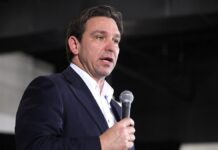Court filings released last month by the House Permanent Select Committee on Intelligence suggest growing evidence of a pay-to-publish scandal that may shake large parts of the Washington press corps.
At the center of the controversy is the Washington DC-based communications shop Fusion GPS, which assembled and distributed the so-called “Steele dossier.” It’s named after former British spy Christopher Steele, who is believed to have authored the document alleging that Donald Trump and members of his campaign colluded with Russia to win the 2016 election. Steele acknowledges that some of the dossier’s information is sourced to Russian officials, including a “top-level intelligence officer.”
In its other Russia-related work, Fusion GPS engaged in a media campaign opposing a law targeting foreign nationals across the globe for human rights abuses. In its advocacy against the Global Magnitsky Act, a worldwide extension of the U.S. legislation imposing sanctions on Russian officials and other figures associated with the Russian government for their involvement in the detention and death of Russian lawyer Sergei Magnitsky, Fusion GPS mirrored Kremlin talking points.
Now the court filing from the U.S. district court for DC shows that Fusion GPS paid several journalists, including three who reported on “Russia issues relevant to [the committee’s] investigation,” the House Intelligence Committee said in a court filing.
The documents did not release the names of the journalists and media organization.
How Fusion GPS Used Media Contacts
To understand the role Fusion GPS played in promoting and distributing the Steele dossier as well as the company’s work to undermine the Magnitsky Act, we’ll need a fuller account of Fusion GPS’s relationship with the journalism industry its principals left and then cultivated.
The story starts at the Wall Street Journal, which is taking fire from the rest of the profession, plunging the paper into what some have described as a civil war between its traditionally right-wing editorial page and left-leaning news desk.
“I don’t know a single WSJ alum who’s not agog at where that edit page is heading,” tweeted former Wall Street Journal reporter Neil King, reacting to a Journal editorial calling for the firing of Robert Mueller. “WSJ edit page has gone full bats–t, now hosting an op-ed suggesting Trump pardon everyone, including himself,” tweeted former high-ranking Wall Street Journal editor Bill Grueskin, now a professor at the Columbia School of Journalism.
When the Journal’s Kimberley Strassel wrote on the editorial page that plenty of bombshells are to come in the Trump-Russia narrative—about the FBI, the Democratic National Committee, and Fusion GPS—Journal alums told Politico reporter Jason Schwartz that was all crazy talk. The real story, they suggested, was that News Corp owner Rupert Murdoch had whispered in Journal editor Gerard Baker’s ear that the paper better support Trump or else.
The Journal took the unusual step of responding to the Politico article, chastising the publication for omitting key details—like the fact that King is now employed by Fusion GPS. “Mr. Schwartz,” the editorial continued, “also failed to point out that Mr. King’s wife, Shailagh Murray, also a former Journal reporter, worked in the Obama White House. Perhaps Mr. Schwartz understands that this kind of political incestuousness is so routine in Washington that even to mention it would get him drummed out of the club.”
That is, the Journal suggested the Politico writer was in on a game whose major players include Fusion GPS and Democratic operatives like Murray, in which the press’s role is to credential the fruits of Fusion GPS’s oppo research as legitimate news stories.
“Our reporting on Fusion GPS is unrelated to where its employees used to work,” Wall Street Journal editorial page editor Paul Gigot wrote me in an email. “We think the story of Russian meddling in the 2016 election is important, and where we differ with the rest of the press corps is that we think the story of Fusion’s ties to Russia and the Steele dossier, as well as the dossier’s influence on the FBI, are also important to investigate. Let’s get the full Russia story.”
Former WSJ Reporters Now Push Russiagate Story
Fusion GPS’s principals—Glenn Simpson, Peter Fritsch, Thomas Catan, and King—are all Journal alumni. Moreover, several other former Journal hands employed throughout the Washington DC press corps to cover the Russiagate beat have teamed with the Fusion four. Because Journal alums played a key role not only in creating the Great Kremlin Conspiracy but also in disseminating it, it is natural that the Journal would find itself in the middle of the story. It appears its newsroom is still influenced by the former staffers driving the Russiagate tale.
William Browder, the driving force behind the Magnitsky Act, told me recently about his experience with the Journal’s newsroom and its relationship with the firm four former WSJ reporters have found. “When I was trying to get journalists interested in a story about the role Fusion GPS was playing in trying to undo the Magnitsky Act,” said Browder, “I found that the Wall Street Journal was one of the places where Glenn Simpson and Fusion GPS were deeply entrenched in the newsroom.” Wall Street Journal editor Gerard Baker did not reply to a request for comment on Browder’s assertions.
The Fusion GPS story doesn’t end with the Wall Street Journal. It only started there. Recently The Daily Caller reported on CNN reporter Evan Perez’s ties to Fusion GPS, showing photographs of Perez with Fritsch and King, with whom he shared bylines at the Wall Street Journal before they went to Fusion GPS and he moved to CNN. Perez had the lead byline on CNN’s January 10, 2017, story that broke how four U.S. intelligence chiefs briefed incoming president Trump and outgoing President Obama on the Steele dossier. The CNN story made no mention of Perez’s friends and former colleagues who produced and distributed the dossier that was the subject of the story.
Former WSJ reporter Adam Entous, recently hired by the New Yorker, had the lead byline on the Washington Post article breaking the news that Marc Elias, a lawyer from the DC law firm Perkins Coie, hired Fusion GPS to compile an opposition research file on Trump for the Democratic National Committee (DNC) and the Clinton campaign. After the story broke, New York Times reporters Maggie Haberman and Ken Vogel expressed their professional frustration on Twitter. They were after the story, and someone else nailed it.
“Folks involved in funding this lied about it, and with sanctimony, for a year,” tweeted Haberman. “When I tried to report this story,” wrote Vogel, “Clinton campaign lawyer @marceelias pushed back vigorously, saying ‘You (or your sources) are wrong.’”
So how did the Post get the Clinton campaign, DNC, or Elias to confirm the story? There’s no evidence they did. A former Clinton spokesman told the paper he wasn’t aware Fusion GPS was hired. A DNC spokesperson said the new leadership was not part of the decision-making. “Elias and Fusion GPS,” according to the Post report, “declined to comment on the arrangement.”
That leaves the firm’s principals as Entous’ most likely sources. Why? Because Fusion GPS and its principals had an interest in dumping information to deter the House Permanent Select Committee on Intelligence from successfully subpoenaing the company’s bank records for evidence that Fusion GPS paid journalists. “Entous,” said one veteran journalist familiar with the national security beat, “is tight with Fusion GPS.”
Feeding Friendly Media Anti-Trump Smears
Carol Lee of NBC News is another WSJ alum. At her new job she has worked on Russiagate stories with Ken Dilanian, a reporter Browder believes to be a regular and reliable purveyor of Fusion GPS-manufactured talking points. In September, for instance, Lee and Dilanian broke a story about the June 2016 meeting between Donald Trump Jr. and Russian lawyer Natalia Veselnitskaya, which also included Jared Kushner and Paul Manafort.
Lee and Dilanian reported, “Two sources tell NBC News that Manafort’s smartphone notes from the meeting included the words ‘donations’ in proximity to the reference to the Republican National Committee.” NBC News was eventually forced to walk back the story when it turned out the word on Manafort’s phone was “donors,” not “donations,” a difference that nullified the thrust of the story, which was to suggest that Russia was funneling money directly to the Trump campaign.
But who fed Lee and Dilanian their story? It seems likely from the list of people at the meeting that their sources included Veselnitskaya herself and another Russian at the meeting, Rinat Akhmetshin—who both had partnered with Fusion GPS to try to undo the Magnitsky Act on behalf of pro-Putin elements. Indeed, Simpson met with Veselnitskaya before and after her meeting with Trump Jr.—a meeting Simpson says he didn’t know about until it was later reported.
The network of journalists who take dossiers from Fusion GPS is rich and deep, which is how the company manages to seed so many stories around the media and make its money. Others whose tenure at the Wall Street Journal intersected with those of Fusion GPS principals and who have filed numerous stories on the Trump-Russia narrative that originated with Fusion GPS’s “Steele” dossier include, among others, Devlin Barrett and Tom Hamburger of the Washington Post, and Matthew Rosenberg of the New York Times.
Paid Mouthpieces for Unknown Interests
Journalism is hardly the only industry networked not just by the work it produces, but also the values and professional ethics it reproduces. Thus the picture of the American news media that emerges from all this hush-hush, buddy-buddy back and forth isn’t pretty.
Much of the fourth estate, it seems, is a world of Renfields, grotesque courtiers gorging on scraps left at the master’s table: reporters who conceal the for-profit sources that pay them and coordinate campaigns of political warfare with the partisan operatives and intelligence officials they’re supposed to be reporting on; and editors who publish conspiracies drawn from a platform for a Russian-manufactured disinformation operation furnished by former colleagues advocating on behalf of a pro-Kremlin interests to undermine American law. Why have they pushed a narrative based on a dossier that they couldn’t verify? Because they couldn’t abide the results of an American election.
For nearly a year most of the press—with the exception of Yahoo News and Mother Jones—held off from reporting on the dossier because they couldn’t discern how much, if any, of it, was true. It was Barack Obama who put it back in play when, as CNN reported, his four intelligence chiefs briefed the newly elected Trump in early January 2017.
“One reason the nation’s intelligence chiefs took the extraordinary step of including the synopsis in the briefing documents was to make the President-elect aware that such allegations involving him are circulating among intelligence agencies,” reported CNN.
No, the point was to provide a pretext for a press that before the election had refrained from publishing the dossier to now put it out in the open. With the briefing, Obama’s intelligence chiefs had re-credentialed Fusion GPS’s oppo research as a news story. Now it was legitimate. Then the feeding frenzy began.
Corrupt Institutions Can’t Stop Corruption
Who knows how editors and journalists justify to themselves promoting a storyline based on a dossier that their journalistic ethics had previously rejected. Maybe they convinced themselves that the fate of the American press, or America itself, actually depended on promoting the dossier to jam a spike in Trump’s wheels. There was no telling what the mad, press-hating tweeter-in-chief might do once in office.
And if it weren’t for the Trump-Russia narrative, maybe digital subscriptions wouldn’t have surged at the Times and elsewhere over the last quarter. Sure, it would be bad if the tables were turned, and the other side had a noble public servant of its own like Robert Mueller coming after Hillary Clinton on the basis of some “dossier” of hogwash that a Trump donor paid $10 million for then leaked to Steve Bannon at Breitbart —but, well, that’s not happening. Not this time, anyway.
Journalists can try to pretend that none of this happened and that in fact, they are all still the heroes of their imaginations, bravely fighting Nazis and fascists. That the choices they made while playing dress-up are entirely justified by Trump’s awfulness, even if they also weakened the badly damaged structures of an institution that for the past century has been central to the American form of government.
Our political institutions, including the press, are designed to check the power that any one group accrues as a consequence of its sociological dynamics and make it difficult for them to advance their narrow interests, friendships, or whims at the expense of the public. The scandal that now threatens to put a stake through the heart of the media is that it may have been paid to publicize what it knows and has known for more than a year: The Great Kremlin Conspiracy Theory is a hoax.





